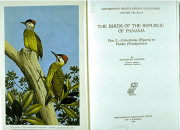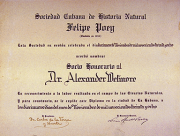Naturalist of the Americas: Alexander Wetmore


Wetmore was appointed assistant secretary of the U.S. National Museum in 1925, where he served for twenty years. Opportunities for field investigations were limited during the Great Depression and World War II. Even so, Wetmore managed to conduct short trips to Haiti, the Dominican Republic, Guatemala, Mexico, Costa Rica, and Colombia. Through his fieldwork, Wetmore established many friendships with Latin American scientists and he strongly encouraged the exchange of specimens and information. He corresponded faithfully with scholars such as Venezuelan botanist Henri Pittier, Brazilian ornithologist Olivario de Pinto, and Brother Apolinar María, the Colombian naturalist. Writing to Secretary Charles Greeley Abbot in 1941, Wetmore expressed delight in finally meeting Apolinar in Bogota after decades of correspondence.

 Wetmore joined cooperative conservation efforts in Latin America when he was appointed U.S. representative to the Pan American Union's Inter-American Committee of Experts on Nature Protection and Wildlife Preservation in 1940. That year he also served as secretary-general of the Eighth American Scientific Congress. In 1946, as Smithsonian Secretary, Wetmore oversaw the transfer of the Barro Colorado Island research station in Panama to the Smithsonian. Deeply concerned about the conservation of Latin American wildlife, he helped to organize the Pan-American Section of the International Council for Bird Preservation.
Wetmore joined cooperative conservation efforts in Latin America when he was appointed U.S. representative to the Pan American Union's Inter-American Committee of Experts on Nature Protection and Wildlife Preservation in 1940. That year he also served as secretary-general of the Eighth American Scientific Congress. In 1946, as Smithsonian Secretary, Wetmore oversaw the transfer of the Barro Colorado Island research station in Panama to the Smithsonian. Deeply concerned about the conservation of Latin American wildlife, he helped to organize the Pan-American Section of the International Council for Bird Preservation.
In the mid-1940s, Wetmore began a research program that would occupy his energies for the remainder of his life. Between 1946 and 1966 he traveled to Panama every year to make an exhaustive survey of the birds of the isthmus.


 This work culminated in the publication of his magnum opus, The Birds of the Republic of Panama -- the last of four volumes was published posthumously in 1984. During his extended stays in remote Indian villages, where the lanky North American was known as "Alejandro Grande," Wetmore learned local customs such as hunting methods. He worked in close association with the scientific community. In 1973, a canopy bridge in the Bayano River Basin in Panama was named in his honor, and he was made an honorary member of many Latin American scientific societies.
This work culminated in the publication of his magnum opus, The Birds of the Republic of Panama -- the last of four volumes was published posthumously in 1984. During his extended stays in remote Indian villages, where the lanky North American was known as "Alejandro Grande," Wetmore learned local customs such as hunting methods. He worked in close association with the scientific community. In 1973, a canopy bridge in the Bayano River Basin in Panama was named in his honor, and he was made an honorary member of many Latin American scientific societies.
Wetmore donated his enormous natural history collections to the Smithsonian. Included were 26,058 bird and mammal skins from the Americas; 4,363 skeletal and anatomical specimens; and 201 clutches of birds' eggs. Fifty-six new genera, species, and sub-species of birds (both recent and fossil), mammals, amphibians, insects, mollusks, and plants were named in his honor -- an assemblage Wetmore called his "private zoo." He was the first to describe 189 species and subspecies of recent birds, mostly from Central and northern South America. An authority on the extinct Pleistocene birds of the West Indies, he had studied fossil avifaunas from Puerto Rico, Haiti, Cuba, and the Bahamas. Avian paleontologist Pierce Brodkorb, when dedicating a newly discovered fossil bird to Wetmore in 1959, stated that he was "responsible for all previous knowledge of fossil birds of the West Indies."

